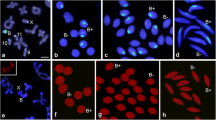Abstract
The two X chromosomes in tetraploid spermatogonial cells from Gryllotalpa fossor respond differentially to the production of chromatid aberrations by 3H-uridine (3H-U). As in diploid female somatic cells, only the euchromatic arm of one X shows such aberrations. The equivalent arm of the other X and the constitutive arms of both Xs are not affected. This differential response of the homologous arms of the two Xs appears to be due to a facultative heterochromatinization of one of them. It is suggested that an imprinting process, which has been assumed to occur during fertilization in other cases of X-inactivation, may not be necessary for the differential regulation of two X chromosomes in this case.
Similar content being viewed by others
References
Arora, Paramjit., Rao, S.R.V.: Insect Sex Chromosomes II. Mitomycin induced aberrations in the X chromosome of the mole cricket, Gryllotalpa fossor (Scudder). The Nucleus (Calcutta) (in press, 1979)
Arora, Paramjit., Rao, S.R.V.: Insect Sex Chromosomes IV. DNA replication in the chromosomes of Gryllotalpa fossor. Cytobios (in press, 1980)
Brown, S.W., Chandra, H.S.: Chromosome imprinting and the differential regulation of homologous chromosomes. In: Cell Biol. 1, 110–189 (L. Goldstein and D.M. Prescott, eds.). New York, London Academic Press Inc., 1977
Chandra, H.S., Brown, S.W.: Chromosome imprinting and the mammalian X chromosome. Nature (Lond.) 253, 165–168 (1975)
Donald, J.A., Cooper, D.W.: Studies on metatherian sex chromosomes III. The use of tritiated uridine-induced chromosome aberration to distinguish active and inactive X chromosome. Aust. J. biol. Sci. 30, 103–114 (1977)
Gartler, S.M., Andina, R.J.: Mammalian X-chromosome inactivation. In Advanc. Hum. Genet. 7, 99–140 (1976)
Kaufman, M.H., Guc-Cubrilo, M., Lyon, M.F.: X chromosome inactivation in diploid parthenogenetic mouse embryos. Nature (Lond.) 271, 547–549 (1978)
Lifschytz, E., Lindsley, D.L.: The role of X-chromosome inactivation during spermatogenesis. Proc. nat. Acad. Sci. (Wash.) 69, 182–186 (1972)
Monesi, V.: Differential rate of ribonucleic acid synthesis in autosomes and sex chromosomes during male meiosis in the mouse. Chromosoma (Berl.) 17, 11–21 (1965)
Natarajan, A.T., Sharma, R.P.: Tritiated uridine induced chromosome aberration in relation to heterochromatin and nucleolar organisation in Microtus agrestis L. Chromosoma (Berl.) 34, 168–182 (1971)
Odartchenko, N., Pavillard, M.: Late DNA replication in male mouse meiotic chromosomes. Science 167, 1133–1134 (1970)
Rao, S.R.V., Arora, Paramjit.: Insect Sex Chromosomes I. Differential response to 5-Bromodeoxy-uridine of the two X chromosomes in females of the mole cricket. Gryllotalpa fossor (Scudder). Ind. J. exp. Biol. 16, 870–872 (1978)
Rao, S.R.V., Arora, Paramjit.: Insect Sex Chromosomes III. Differential susceptibility of homologous X chromosomes of Gryllotalpa fossor to 3HUrd-induced aberrations. Chromosoma (Berl.) 74, 241–252 (1979)
White, M.J.D.: Asymmetry of heteropycnosis in tetraploid cells of a grasshopper. Chromosoma (Berl.) 30, 51–61 (1970)
White, M.J.D.: Animal Cytology and Evolution, 3rd ed. London, New York: Cambridge University Press (1973)
Author information
Authors and Affiliations
Rights and permissions
About this article
Cite this article
Arora, P., Rao, S.R.V. Insect sex chromosomes. Chromosoma 77, 373–378 (1980). https://doi.org/10.1007/BF00286061
Received:
Accepted:
Issue Date:
DOI: https://doi.org/10.1007/BF00286061




